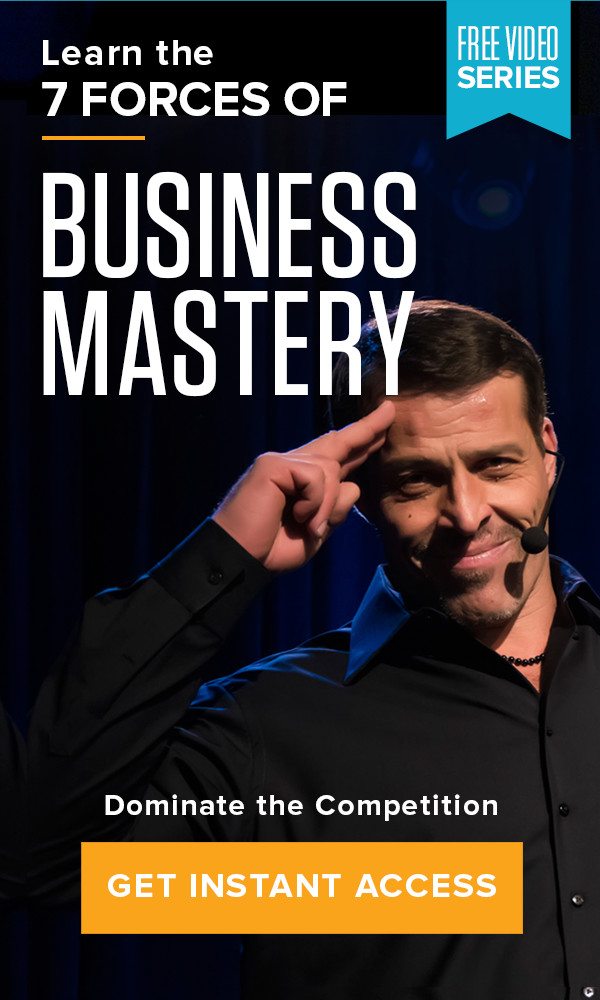Team Tony cultivates, curates and shares Tony Robbins’ stories and core principles, to help others achieve an extraordinary life.
6 proven recruitment strategies
How to get the talent you need to achieve geometric growth
This article was written specifically for the Tony Robbins blog by talent strategy expert, Elatia Abate.
Getting the right people in the door is a perennial challenge for business owners and leaders. Common complaints – from Fortune 500s to early stage startups – center around the lack of effective recruitment strategies and how long the process takes in order to find good people.
Employee recruitment strategies
The goal for every business owner should be to hire a team that not only works, but also one that is made up of raving fans of your business. This does not happen by accident. If you hire like everyone else does, you’ll get the same type of employees – some who may be committed to your company, but many who come to work for the paycheck and who are not passionate about what they do. The goal of effective recruitment strategies is to attract superstars – those who treat your business like their own and who find purpose and value in what they do every day. Not only will this improve your organizational culture, but it will also strengthen your brand and make your company talkably different.
The exciting news is that when done correctly, recruiting can be simple and it can drive your business growth. These nine proven employee recruitment strategies will help you get where you need to be in terms of hiring – all you have to do is change your mindset and incorporate a few small steps into your process.
Types of recruitment strategies
There are a number of recruitment strategies you can choose from. The most effective plans blend a variety of types to come up with an overall approach. Here are some of the most common:
Referral recruitment strategies
When your current employees are happy, they’re likely to encourage friends and acquaintances to apply when job openings arise. You can encourage these referrals with bonuses or reward programs, but the key to this strategy is treating your current employees right.
Social media recruitment strategies
Social media is not only good for fundraising and connecting with customers – it’s also an excellent recruitment tool. Having a solid brand on your social media platforms and getting employees involved is a good way to create an online community that is responsive to job postings.
Event recruitment strategies
Getting out in the community is an excellent way to find candidates and promote your company. Job fairs, networking events and college campus visits are all effective ways to network in-person at events.
Recruitment strategy examples
Looking for more specific recruitment strategy examples? Incorporate several of the following to create a cohesive plan to find and hire superstars.
1. View how to recruit employees as part of the business

Employee recruitment strategies are often viewed as a challenge because business leaders separate the act of hiring from the rest of the business. Urgent tasks like generating revenue, increasing profits and growing market share take immediate precedent; hiring is often relegated to the back burner.
In reality, learning how to recruit employees can make or break your business and should be one of your core business practices. When you add a person to your workforce, you aren’t just pulling their skills into the mix – you’re also adding an entirely different personality with its own set of expectations. You hope they’ll fit in with your existing employees and perform, but failing to do so can severely upset the performance of the business and the company culture – and it’s expensive, too.
Darren Hardy, author of The Entrepreneurial Rollercoaster, notes, “When you’re hiring the wrong person, you’re not only paying them, you’re paying them to light piles of your money on fire, spread a cancer through your building and run your rollercoaster [business] right off the tracks and into the ground.”
Stop seeing recruitment strategies as something entirely separate from your business. Recruitment is your business.
2. Treat recruitment strategies like sales
Employee recruitment strategies are similar to a sales process. Think about it: Your customers and clients buy your products and services because of the value they add to their lives. You reach your target audiences by understanding who they are, what they need and how they communicate. You meet the customer where they are and offer them things they can’t access on their own.
You can apply the same logic to your employee recruitment strategies. Talented candidates are looking for the opportunities and experiences that working in your company can provide. Do you know who they are? Designing a persona for your ideal candidate – including experience, interests and cultural fit – can help you more objectively evaluate applicants. Are you looking for these individuals in the right place – at conferences instead of job boards, for example? Are you using language that speaks to the talent you seek? Are you recruiting on sites or at events that attract talented people in your industry?
You also need to make sure you have a consistent brand. If you have a culture of innovation and collaboration but your website reads more like a tax code, you’re not going to bring in the talent you want.
Meet your talent halfway. You need to locate people who will contribute to your brand; at the same time, you must present your company as a viable option for them since most employees want to be part of a company that aligns with their values and goals.
3. Know your business

Proven recruitment strategies require a clear understanding of where your business is today and where you want to take it moving forward. By understanding these two things, you can prioritize which hires need to come first and where to allocate valuable hiring resources.
One of my clients is a co-founder of an early-stage online startup in the beauty industry. They’re on the brink of closing their first round of funding. The business has already achieved a certain amount of success, and to move the company to its next phase of growth, they have to quickly make additional sales and increase revenue. With that in mind, their first two investments in people once the checks clear will be in digital marketing and sales. Once you realize what you need to make your business stand out, you have a clearer picture of how to recruit employees.
4. There are two parts to every prospect
The best employee recruitment strategies involve seeing applicants in the right way. Picture your ideal candidate being made up of two main factors: skills and style. These are the two elements you need to gauge as you learn how to recruit employees. As you consider each candidate, ask yourself the following: Are they capable of executing the tasks they will need to perform the job well? It seems like a given, but if a hiring executive isn’t clear about what specific skills are needed, even this part can be a shot in the dark.
The second piece is style, or cultural fit. If your company is an energetic, collaborative and innovative place, someone who is a great individual contributor but doesn’t like working in teams isn’t going to fit in. You need someone who will seamlessly merge with your current workforce, collaborate with their peers and focus on the tasks at hand. Understanding their personality and working style is a vital part of your recruitment strategies.
5. Develop a hiring process
You’ve probably heard that employee recruitment strategies take up “too much time.” Yes, hiring can be time-consuming if you’re just guessing at it and deploying whatever ideas come to mind. However, by developing recruitment strategies that you can implement with each candidate, you’ll streamline your process immensely.
Companies often create low barriers for candidates to apply, resulting in wasted time evaluating candidates. For example, you post an ad on Craigslist that reads, “Looking for rock star salespeople who can produce great results and want to be a part of a fun team. Send your résumé to this email if you’re interested.”
What do you think you’re going to get with broad recruitment strategies like this? Hundreds or thousands of résumés from unqualified people that you or someone on your team has to review, that’s what.
Many companies that struggle with finding good employees have problems not because they can’t find candidates – it’s because they find too many who aren’t a good fit. Create a hiring process that has a high barrier to entry. When I ran recruiting for Dow Jones, we built a summer innovation lab for which we hired talented, creative college students. In addition to asking for a résumé and cover letter, we invited candidates to answer essay questions about their own creativity and innovation, as well as do recorded video interviews.
This process ensured that only the most interested and dedicated talent applied, and that those who we did invite for interviews were highly vetted before they walked in the door.
6. Put the interview process to work

Preparing more strategically for the interview itself can help you secure the right people and is a necessary part of proven recruiting plans. Interview time is often eaten up by “getting to know you” conversations. Trim out some of this social element and be deliberate about the questions you’re asking. We all know that asking the right questions is the only way to get the answers we need, so well thought-out queries are key when it comes to how to recruit employees in this stage.
If you know the role you are hiring for requires flexibility under pressure, creative thinking and obsessive attention to detail, have the candidate offer you specific, measurable examples of where they have demonstrated these three qualities. Don’t settle for answers that simply offer a yes or a no. “Tell me more” is a great way to dig into the information that will get you the talent you need to drive your company’s growth. Always have specific questions that align with an open role, and most importantly, don’t forget to keep your brand’s ultimate vision in mind.
About the Author
Elatia is an entrepreneur and thought leader on the future of work, talent strategy and building cultures of creativity and innovation. She works with organizations that range in size from Fortune 500 to early-stage start-ups. She is a sought-after speaker and lecturer, having recently delivered a TEDx titled, “Pioneering The Future of Work.” In a former life she served as Vice President of Human Resources at Dow Jones & Company, and Global Director Talent Acquisition at Anheuser-Busch InBev. Learn more at elatiaabate.com or by following @elaabate on Twitter and Instagram.




